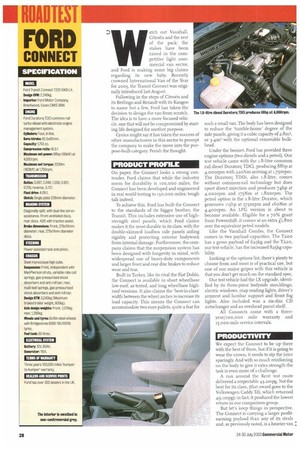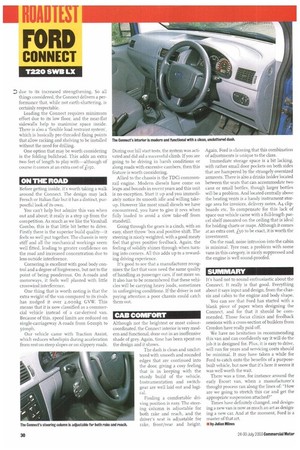FORD TRANSIT CONNECT
Page 26

Page 28

Page 30

If you've noticed an error in this article please click here to report it so we can fix it.
'PRICE AS TESTED: £11,575 (ex-VAT), includes £10,250 for the basic vehicle.* ENGINE: 1.8 litres, 88hp (66kW). GVW: 2,240kg. PAYLOAD: 825kg. AVERAGE FUEL CONSUMPTION: 4318mpg (6.541it/100km). AVERAGE SPEED: 69.77km/h. * Price includes: LX package, £500; six-disc CD autochanger, £275: anti
lock brakes with traction assist and rear discs. £400: passenger airbag, 1150: parcel shelf, £50.
The light commercial van sector is one of the most competitive in the business, with reputations being made or broken on a vehicle's performance. Now Ford has thrown its hat in the ring with an all-new competitor, the Transit Connect.
Replacing both the Escort van and the Fiesta Courier, it has a lot to live up to.
atch out Vauxhall, Citroen and the rest of the pack: the stakes have been raised in the competitive light cornmercial van sector, and Ford is making some big claims regarding its new baby. Recently crowned International Van of the Year for 2003, the Transit Connect was originally introduced last August.
Following in the steps of Citroen and its Berlingo and Renault with its Kangoo to name but a few, Ford has taken the decision to design the van from scratch. The idea is to have a more focused vehicle, one that will not be compromised by starting life designed for another purpose.
Cynics might say it has taken the success of other manufacturers in this sector to prompt the company to make the move into the purpose-built category. Perish the thought.
PRODUCT PROFILE
On paper, the Connect looks a strong contender. Ford claims that while the industry norm for durability is I00,000 miles, the Conned has been developed and engineered in real world testing to 15o,000 miles; tough talk indeed.
To achieve this, Ford has built the Connect to the standards of its bigger brother, the Transit. This includes extensive use of highstrength steel panels, which Ford claims makes it the most durable in its class, with the double-skinned loadbox side panels aiding rigidity and protecting exterior bodywork from internal damage. Furthermore, the company claims that the suspension system has been designed with longevity in mind, with widespread use of heavy-duty components and larger front and rear disc brakes to reduce wear and tear.
Built in Turkey, like its rival the Fiat Doblo, the Conned is available in short wheelbase low-roof, as tested, and long wheelbase highroof versions. It also claims the 'best-in-class' width between the wheel arches to increase its load capacity. This means the Connect can accommodate two euro pallets, quite a feat for such a small van. The body has been designed to reduce the 'tumble-home' degree of the side panels, giving it a cubic capacity of 2.8m3, or 3.4m3 with the optional removable bulkhead.
Under the bonnet, Ford has provided three engine options (two diesels and a petrol). Our test vehicle came with the 1.8-litre common rail diesel Duratorq TDCi, producing 88hp at 4,000rpm with 220Nm arriving at 1,750rpm. The Duratorq TDDi, also r.8-litre, comes without common-rail technology but does sport direct injection and produces 74hp at 4,000rpm and 175Nm at 1,800rpm. The petrol option is the i.8-litre Duratec, which generates it5hp at orpm and 160Nm at 4,400rpm. An LPG version is about to become available. Eligible for a 70% grant from Powershift, it comes at an extra £1,80o over the equivalent petrol models.
Like the Vauxhall Combo, the Connect comes in two payload capacities. The T200 has a gross payload of 625kg and the T220, our test vehicle, has the increased 825kg capability.
Looking at the options list, there's plenty to choose from and most is of practical use, but one of our major gripes with this vehicle is that you don't get much on the standard spec.
Our test vehicle had the LX upgrade, identified by its three-piece bodyside mouldings, electric windows, map reading lights, driver's armrest and lumbar support and front fog lights. Also included was a six-disc CD autochanger and an overhead parcel shelf.
All Connects come with a threeyear/i oo,o oo mile warranty and 15,000-mile service intervals.
PRODUCTIVITY
We expect the Connect to be up there with the best of them, but if it is going to wear the crown, it needs to sip the juice sparingly. And with so much reinforcing on the body to give it extra strength the task is even more of a challenge.
A run around the Kent test route delivered a respectable 43.mpg. Not the best for its class, that award goes to the Volkswagen Caddy Tdi, which returned 49.Impg); in fact, it produced the lowest return in our comparison group.
But let's keep things in perspective. The Connect is carrying a larger profitearning payload than any of its rivals and, as previously noted, is a heavier van :
D due to its increased strengthening. So all things considered, the Connect delivers a performance that, while not earth-shattering, is certainly respectable.
Loading the Connect requires minimum effort due to its low floor, and the near-flat sidewalls help to maximise space inside. There is also a 'flexible load restraint system', which is basically pre-threaded fixing points that allow racking and shelving to be installed without the need for drilling.
One option that may be worth considering is the folding bulkhead. This adds an extra two feet of length to play with—although of course it comes at an extra cost of itso.
ON THE ROAD
Before getting inside, it's worth taking a walk around the Connect. The design may lack French or Italian flair but it has a distinct, purposeful look of its own.
You can't help but admire this van when out and about; it really is a step up from the competition. As much as we like the Vauxhall Combo, this is that little bit better to drive. Firstly there is the superior build quality—it feels so well put together. The chassis is very stiff and all the mechanical workings seem well fitted, leading to greater confidence on the road and increased concentration due to less outside interference.
Cornering is excellent with good body control and a degree of forgiveness, but not to the point of being ponderous. On A-roads and motorways, it feels well planted with little crosswind interference.
One thing that is worth noting is that the extra weight of the van compared to its rivals has nudged it over 2,000kg GVW. This means that it is now classified as a commercial vehicle instead of a car-derived van. Because of this, speed limits are reduced on single-carriageway A-roads from Gomph to 5omph.
Our vehicle came with Traction Assist, which reduces wheelspin during acceleration from rest on steep slopes or on slippery roads.
During our hill start tests, the system was activated and did aid a successful climb. If you are going to be driving in harsh conditions or along roads with excessive cambers, then this feature is worth considering.
Allied to the chassis is the TDCi commonrail engine. Modern diesels have come on leaps and bounds in recent years and this unit is no exception. Start it up and you immediately notice its smooth idle and willing takeup. However like most small diesels we have encountered, you have to give it revs when fully loaded to avoid a slow take-off from standstill.
Going through the gears is a cinch, with an easy. short throw 'box and positive shift. The steering is nicely weighted, with a good meaty feel that gives positive feedback. Again, the feeling of solidity shines through when turning into corners. All this adds up to a rewarding driving experience.
It's good to see that a manufacturer recognises the fact that vans need the same quality of handling as passenger cars, if not more so. It also has to be remembered that these vehicles will be carrying heavy loads, sometimes in unforgiving conditions. If the driver is not paying attention a poor chassis could catch them out.
CAB COMFORT
Although not the brightest or most colourcoordinated, the Connect interior is very modern and functional, done out in an inoffensive shade of grey. Again, time has been spent on the design and it shows.
The dash is clean and uncluttered with smooth and rounded edges that are continued into the door, giving a cosy feeling that is in keeping with the sturdy build of the vehicle. Instrumentation and switchgear are well laid out and logical.
Finding a comfortable driving position is easy. The steering column is adjustable for both rake and reach, and the driver's seat is adjustable for rake, front/rear and height. Again, Ford is claiming that this combination of adjustments is unique to the class.
Immediate storage space is a bit lacking, with rather small door pockets on both sides that are hampered by the strangely oversized armrests. There is also a drinks holder located between the seats that can accommodate two cans or small bottles, though larger bottles will be a problem. And located centrally above the heating vents is a handy instrument storage area for invoices, delivery notes, A4 clipboards etc. To compensate for this lack of space our vehicle came with a full-length parcel shelf mounted on the ceiling that is ideal for holding charts or maps. Although it comes at an extra cost, is o to be exact, it is worth the investment.
On the road, noise intrusion into the cabin is minimal. Tyre roar, a problem with some vans in this category, is nicely suppressed and the engine is well sound-proofed.
SUMMARY
It's hard not to sound enthusiastic about the Connect. It really is that good. Everything about it says input and design, from the chassis and cabin to the engine and body shape.
You can see that Ford has started with a blank piece of paper when designing the Connect, and for that it should be commended. Those focus clinics and feedback sessions with a cross-section of builders from Croydon have really paid off We have no hesitation in recommending this van and can confidently say it will do the job it is designed for. Plus, it is easy to drive, will run for years and servicing costs should be minimal. It may have taken a while for Ford to catch onto the benefits of a purposebuilt vehicle, but now that it's here it seems it was well worth the wait.
There was a time, for instance around the early Escort van, when a manufacturer's thought process ran along the lines of: "How are we going to stretch this car and get the appropriate suspension attached?"
Times have definitely changed, and designing a new van is now as much an art as designing a new car. And at the moment, Ford is a master of that art.
• by Julian Milnes




























































































































































